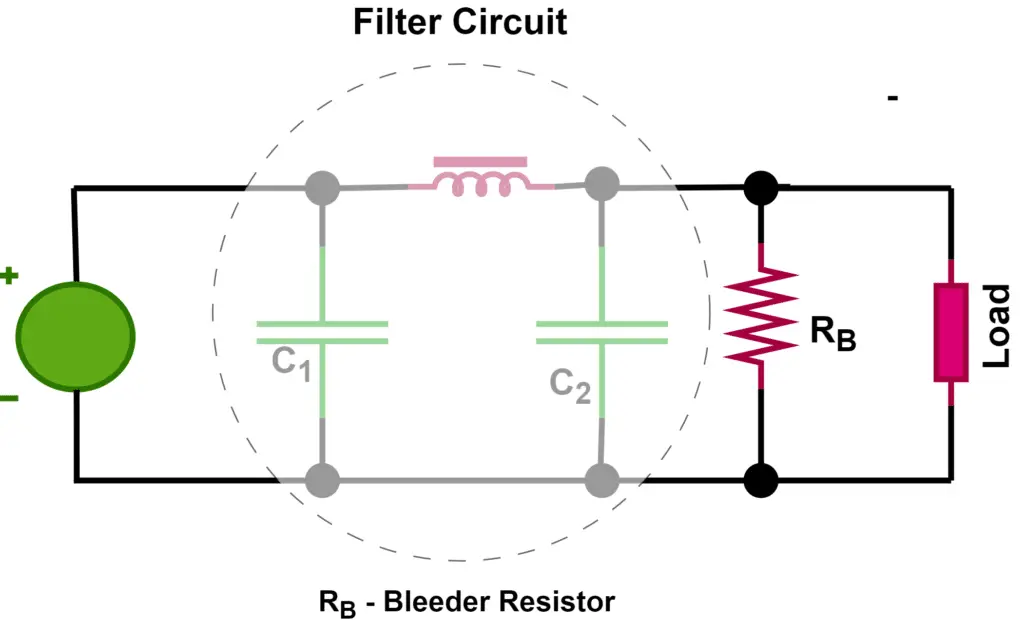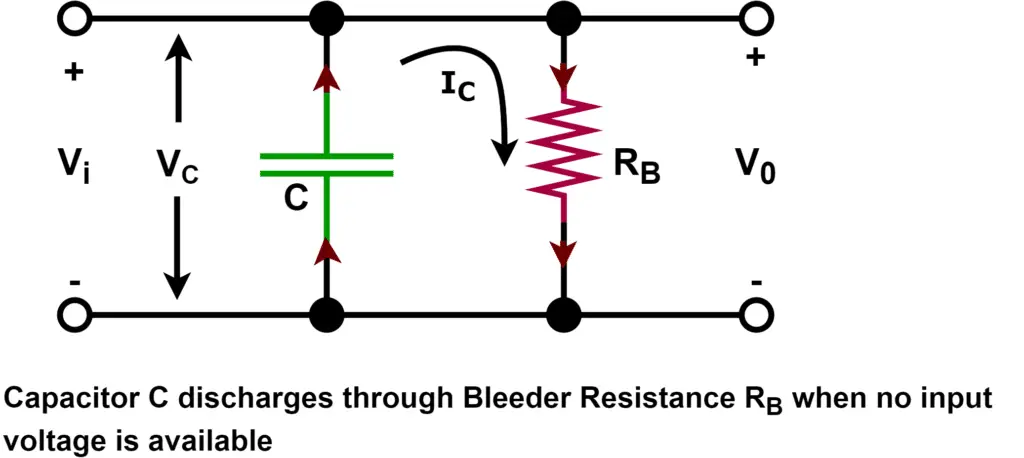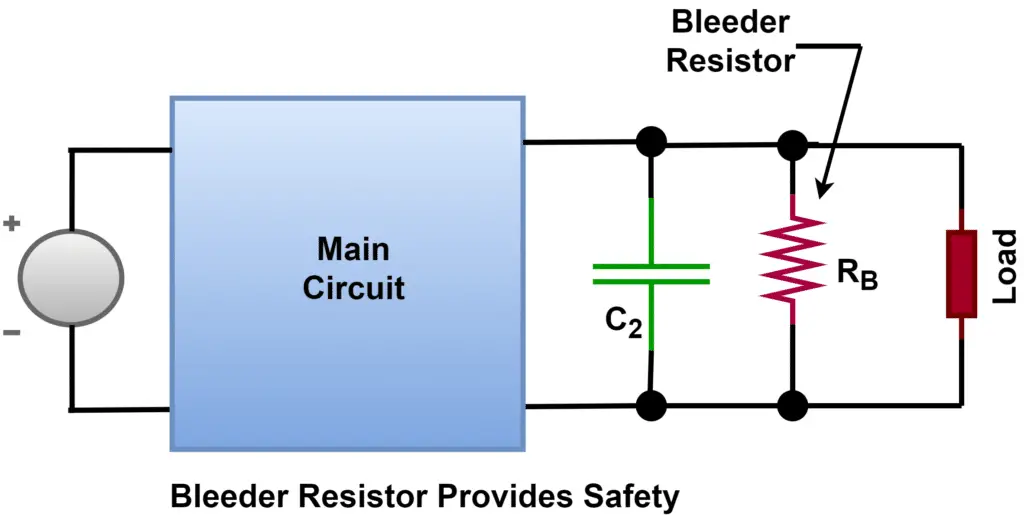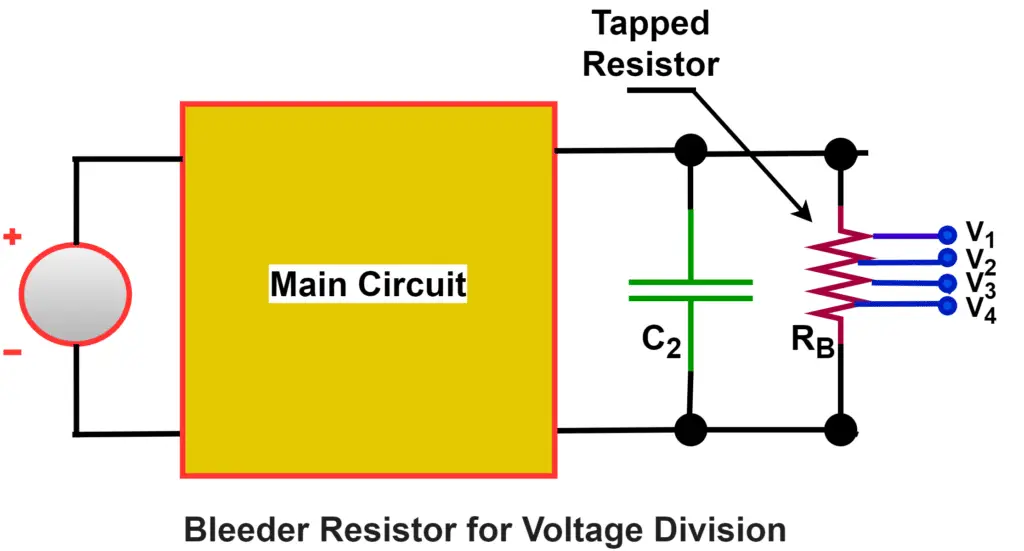A Bleeder resistor is a simple resistor that is mainly used as a protection device against high-voltage electric shock that an operator can be subjected to while handling an electrical device that has high voltage output.
The bleeder resistor is also called a capacitor discharge resistor or safety discharge resistor.
There are various electrical devices where capacitors and inductors are used as filter devices in order to filter out harmonics or ripples in the output signal. This is necessary as these ripples in the output voltage from the circuit may cause severe malfunction to a sensitive device connected to it (viz. a chargeable battery).
That’s why filtration of the output power is done using series-connected inductor(s) and parallel-connected capacitor(s). Capacitors control the output voltage and remove the ripples while inductors do the same for the output current.
Why is Bleeder Resistor Used?
Both capacitors and inductors are energy-storing devices which means these can hold voltages even if the power supply has been cut-off. As a result, if someone touches the output terminal of the circuit even when the circuit has its input supply being cut off, the person can be subjected to substantial electrical shock and even burn injury as the electrical charge holding capacitors/inductors discharges through the person.
That’s why a bleeder resistor is connected to the circuit in order to discharge the filter capacitors and inductors efficiently and safely. The Bleeder resistor is connected in parallel to the filter capacitor as shown in the picture below.

As shown in the picture, the load is connected to a circuit that has a filter circuit connected with the input supply which is the output of any DC voltage-producing circuit like a rectifier. For simplicity, it has been shown as a DC EMF source. C1 and C2 both are filter capacitors while an inductor is connected in series for the same purpose. Rb is the bleeder resistor that discharges the capacitors C1 and C2 when the load is disconnected. If this resistor is not present then the voltage held by the capacitors will appear at the output which can give a fatal electrical shock and burn to a person handling it.
Selection of Bleeder Resistor
The selection of a proper bleeder resistor is important. A low-value bleeder resistor may help in faster discharge but will end up consuming more power than required which will be dissipated as heat. This is because the bleeder resistor is connected in parallel and thus the power consumed by it is given as

It is evident from the equation that a low-value resistor may result in greater power loss in the form of heat which will reduce the efficiency of the circuit.
While it may appear that a high-value resistor can be a solution, it is not the case. Because a high-value resistor will have a lower bleeding rate than required which will result in a slow discharge of the energy stored circuit elements. This will defeat the entire purpose of adding a Bleeder resistor.
It is therefore clear that we have to trade off between Bleeder resistor performance and its power consumption. Thus, a resistor of nominal value is required which can consume less power and has a sufficient bleeding rate.
Calculation of Bleeder Resistor
The discharging capacitor connected in parallel to the bleeder resistor constitutes an RC discharging circuit.

Therefore we can make use of the RC circuit equation in order to find out the appropriate value of the resistor. The capacitor discharges across the resistor in absence of any input power. However, this discharge is not instantaneous as the capacitor opposes the sudden change of voltage across it. Thus, the discharge takes some time depending on the value of both the resistor and the capacitor. It can be represented by a negative exponential equation.

Therefore, we can calculate the Value of a Bleeder Resistor;

Ideally, the capacitor voltage should be zero when the circuit is in a cut-off state. However, by putting the capacitor voltage equal to zero in the above equation, we will find that the discharging time required by the resistor is infinite. Thus, the designer needs to select a safe voltage limit and add a suitable bleeder resistor to the circuit.
Applications of Bleeder Resistor
1. Safety
They are used in high-voltage power supplies and capacitors to discharge them safely when they are turned off. This prevents the risk of electric shock and also prevents damage to the equipment. The circuit diagram with a bleeder resistor is shown in the below picture.

Filter circuits are widely used in electrical and electronic circuitry. The main elements of the filter circuit are the inductor and capacitor. These filter elements store energy on receiving power, however, they can’t discharge or discharge very slowly after removing the power. To discharge the stored energy, the bleeder resistance is connected parallel to the filter capacitor. On turning off the filter circuit, the energy stored in the capacitor is discharged in the form of heat energy in the bleeder resistor and thus, the capacitor’s voltage decays to zero in a short period of time.
2. Voltage Regulation/Voltage Stabilization
Bleeder resistors are used in voltage regulators to stabilize the output voltage. The resistor is connected across the output terminals of the regulator to provide a path for the excess current, which stabilizes the voltage.
Voltage regulation is defined as the change of voltage from no-load to full-load with respect to full-load voltage. It is given as

For a good system, the value of Voltage Regulation should be as low as possible. The ideal value is zero voltage regulation which means the output voltage remains constant at no load as well as at full load. However, that is not possible practically as there will be some voltage drop at full load condition.
The addition of a Bleeder Resistor decreases Voltage regulation as it acts as a load itself when the actual load is disconnected because it is added in parallel to the actual load. Thus, the resistor helps in keeping voltage regulation as low as possible.
3. Filter circuits
Bleeder resistors are used in filter circuits to discharge the capacitors used in the filter. This prevents the capacitors from holding a residual charge, which can affect the performance of the circuit.
4. Audio circuits
Bleeder resistors are used in audio circuits to prevent popping sounds that can occur when a switch is turned off. The resistor discharges any residual charge in the circuit, preventing the popping sound.
5. Power supplies
These types of resistors are used in power supplies to discharge the high-voltage capacitors used in the power supply. This prevents the capacitors from holding a residual charge, which can damage the power supply or any equipment connected to it.
6. Testing and measurement
Bleeder resistors are used in testing and measurement applications to discharge capacitors before they are tested. This ensures that accurate measurements are obtained and prevents damage to the testing equipment.
7. Voltage Division
If you want to get multiple voltages from a single voltage, you can use a bleeder resistor as a tapped resistor in the circuit. The circuit diagram of the voltage division circuit is given below.

Overall, these types of resistors are used to safely discharge electrical energy from capacitors and high-voltage power supplies, stabilize voltage output, prevent popping sounds, filter circuits, and protect equipment from damage.
Disadvantages of Bleeder Resistor
The followings are the disadvantages.
1. Power Consumption
Bleeder resistors consume power even when the circuit is turned off, which can be wasteful and reduce the overall efficiency of the circuit. Also, it consumes power during the circuit is in an energization state.
2. Heat Dissipation
Bleeder resistors generate heat as they discharge the energy stored in capacitors or power supplies. If the resistor is not properly sized for the application, it can overheat and fail.
3. Size and weight
In some applications, the size and weight of the bleeder resistor can be an issue. Large power supplies may require a significant amount of energy to be discharged, which may require a larger, heavier resistor.
4. Time to discharge
The time it takes for a bleeder resistor to discharge a capacitor or power supply may be too slow in some applications, which could affect the performance of the circuit.
Overall, while bleeder resistors offer several benefits, they also have some disadvantages, including power consumption, heat dissipation, size and weight, and time to discharge. However, the advantages of using a bleeder resistor typically outweigh the disadvantages, making it a valuable component in many electronic circuits.